If you’re researching TPLO surgery for dogs, this article is for you. Dr. Andrea Gibbs, friend of integrative veterinarian Dr. Julie Buzby, explains TPLO surgery, how it measures up to the other surgical options for a torn cruciate ligament, and what to expect during TPLO recovery. Plus, Dr. Gibbs shares the story of her own dog, Oliver, who had TPLO surgery.

As third-year veterinary student at the time, I had learned about cranial cruciate ligament tears and the various surgical techniques, including TPLO (tibial plateau leveling osteotomy) surgery for dogs. But I certainly didn’t think I’d soon be facing TPLO surgery with my 18-month-old Great Dane, Oliver.
However, after an ill-fated romp in the dog park, that’s exactly where I found myself.
I can still clearly remember calling my mom in tears after I found out Oliver tore his cruciate and needed TPLO surgery. Even as a soon-to-be veterinarian, TPLO surgery sounded overwhelming.
So I understand how dog parents feel when they get the same news. It can be a lot to digest. Hopefully though, learning the facts about TPLO surgery can help you feel more prepared.
What is the cranial cruciate ligament (CCL)?
When a dog tears his or her cranial cruciate ligament, surgery is the gold standard treatment. This is the case because the cranial cruciate ligament is one of the main structures that helps stabilize a dog’s stifle joint (i.e. knee joint).
Normally, the cruciate ligament helps keep the top of the tibia (i.e. shin bone) from sliding forward beneath the bottom of the femur (i.e. thigh bone) when the dog puts weight on the leg. (Or alternatively, you could say it stops the femur from sliding down the slanted back of the tibia. Both phrases describe the same action.)

However, when the cruciate ligament tears, the joint loses stability. And as the tibia slides out from under the femur with each step, the knee becomes inflamed and painful.
What causes a cruciate ligament tear in dogs?
Humans tend to traumatically tear their anterior cruciate ligament (ACL)—for example by jumping, twisting, or landing wrong. However, a torn ACL in dogs happens a bit differently.
Often, a dog’s cruciate ligament begins to slowly degenerate. Over time, it frays like a well-used rope. Eventually, just like that worn out rope, the cruciate ligament will break. It may appear that the rupture was sudden, but in reality, it is usually a long time in coming.
What are the symptoms of a torn CCL in dogs?
When a dog tears his or her cruciate ligament, you may notice:
- Sudden limping on a rear leg (which is sometimes severe enough that the dog is barely bearing weight on the leg or is holding it up)
- Intermittent limping on a back leg (which may be a sign that the cruciate is starting to degenerate or the dog has a partial CCL tear)
- Difficulty rising or jumping into the car or onto furniture
- Sitting with the affected leg out to the side
There are other potential signs related to pain and joint instability, but these are some of the most common ones.
What are the surgical options for a torn CCL?
If the vet diagnoses a dog with a torn cruciate ligament, he or she will most likely recommend surgery to correct the joint instability. When it comes to dog knee surgery, TPLO procedures tend to be a popular choice.
TPLO surgery for dogs
For a TPLO (tibial plateau leveling osteotomy), the orthopedic surgeon uses a special saw blade to make a semicircular cut in the back part of the shin bone (tibia). This frees the tibial plateau (i.e. weight-bearing surface of the tibia where it meets the femur) from the rest of the tibia. Then the orthopedic surgeon rotates that cut piece to a pre-calculated position that will flatten the tibial plateau.
After achieving the proper angle, the surgeon will use a specially designed bone plate and screws to hold the cut portion of the tibia in the new orientation. Over time, the bone will heal together again.
Leveling the tibial plateau is effective because normally the tibial plateau slopes backward (i.e. toward the dog’s tail). An intact CCL anchors the femur to the tibia so the femur can’t slide down the tibial plateau. However, without the CCL, the femur slips down the back of the tibia.
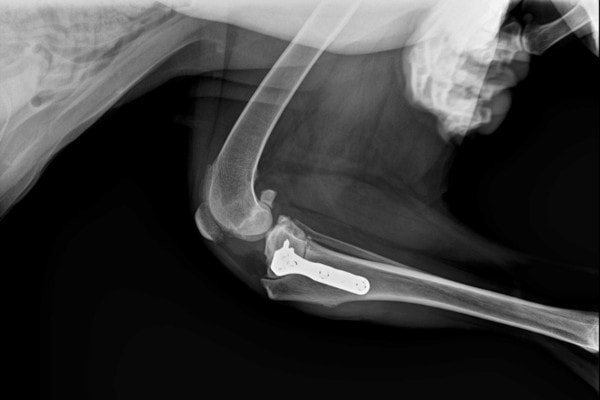
By flattening the tibial plateau angle, a TPLO knee surgery for dogs keeps the femur from continuing to slide down the back of the tibia and eliminates the need for a CCL.
There are also several procedures that are alternatives to TPLO surgery. They include:
CBLO surgery for dogs
The CBLO or CORA (center of rotation of angulation) based leveling osteotomy is a relatively new procedure which works on a similar principle to the TPLO. It also uses a cut in the bone to change the angle of the top of the tibia and stop the tibia and femur from slipping past each other. However, the cut is slightly further down on the tibia than in a TPLO and has a different shape.
TPLO vs. CBLO
Currently, there are no studies comparing the long-term outcomes of a TPLO and CBLO. Hopefully, they will be coming in the next few years.
ELSS (lateral suture) surgery for dogs
The extracapsular lateral suture stabilization (ELSS) procedure involves placing a strong suture through the front of the tibia and around a small bone (the fabella) behind the femur to help anchor the tibia and femur in place. This helps keep the tibia from sliding out under the femur.
TPLO vs lateral suture
When compared to ELSS (lateral suture), two studies indicated that dogs with a TPLO surgery consistently had higher force-plate readings (bearing more weight) for the operated limb. One of these studies also showed that dogs who underwent TPLO surgery had limb function that was indistinguishable from a normal dog at one year post-op. Additionally, the study found that 93% of owners were satisfied with the outcome of their dog’s TPLO. This is in contrast to the 73% of dog parents who were happy with the lateral suture procedure.
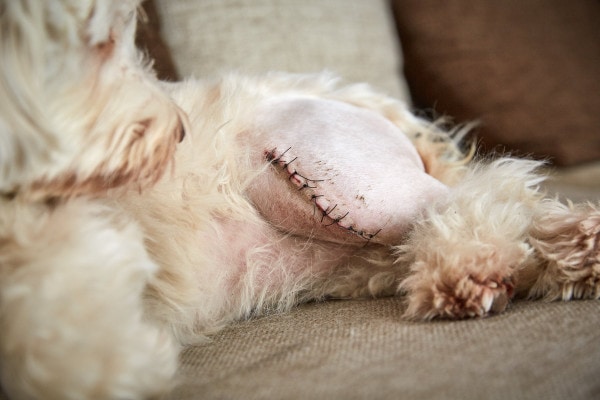
TTA surgery for dogs
In a TTA (tibial tuberosity advancement) surgery, the surgeon cuts off the tibial tuberosity (i.e. the front part of the tibia where the patellar ligament attaches). Then he or she uses a spacer and bone plate to position the tibial tuberosity further forward and higher than before. This changes the angle of the forces across the knee to reduce the tibia slipping under the femur.
TPLO vs TTA
The same research group that looked at the lateral suture vs TPLO performed a similar study to compare the TPLO to the TTA. They determined that when walking, dogs with both surgical procedures showed normal limb function. However, dogs who had a TTA had inferior limb function when trotting compared to TPLO dogs. This may be significant because subtle lameness is easier to notice in a trotting dog.
Evaluation of the knee joint during surgery
During all of these procedures, the surgeon typically also inspects the other structures in the joint. Many dogs who tear their cruciate ligament also injure their meniscus (i.e. shock absorbing cartilage in the knee). Thus, the veterinary surgeon may need to remove the torn portion of the meniscus.
The surgeon may also decide to do a meniscal release procedure, which allows the meniscus to move more freely. Some surgeons feel this procedure reduces the chances of further meniscal injury down the road. However, recent research indicates that the meniscal release procedure may increase the rate of onset of arthritis and interfere with knee stability.
Therefore, the surgeon will decide on a case-by-case basis what, if anything, needs to be done with the meniscus.
Which dogs are good candidates for TPLO surgery?
While the research shared here does point to TPLO being a great option for many dogs with a CCL tear, all four surgeries have their pros and cons. Therefore, it is up to the veterinary surgeon to decide which one is right for your dog’s particular situation. There isn’t a one-size-fits all solution for cruciate injuries in dogs.
However, the great news about TPLO surgery is that it is very versatile. The saw blades and bone plates come in a range of sizes that work for an array of patient sizes and situations. It is a great choice for:
- Giant breed dogs—These dogs may be too big for other repair techniques such as an ELSS or TTA, but do well with a TPLO.
- Smaller breed dogs—They are prone to having a higher tibial plateau angle which makes it more difficult to successfully perform a TTA. However, ELSS also can be a good, and sometimes more cost effective, solution for small breed dogs.
- Medium to large breed dogs—This tends to be the group who experiences cruciate ruptures most frequently. And TPLOs are highly successful for them.
- Working and agility dogs—TPLO surgery is thought to offer the best chances of returning to previous athletic function. A study of agility dogs who underwent TPLO surgery indicated a good prognosis for return to competition. This is great news for doggy athletes.
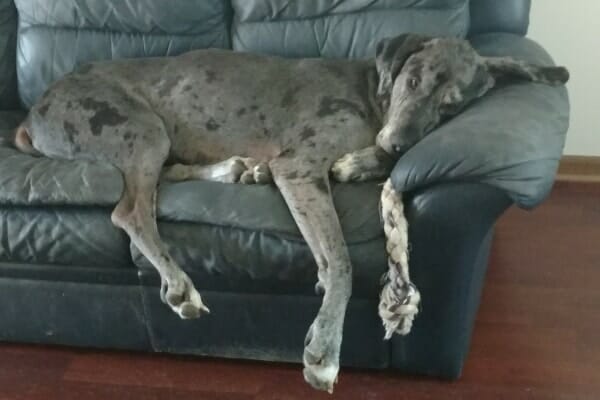
What does preparation for TPLO surgery involve?
If your vet thinks a TPLO surgery could be right for your dog, he or she will refer you to a veterinary specialist near you who regularly performs this surgery (as well as other orthopedic surgeries). A TPLO takes considerable surgical experience and specialized tools. So it is not a procedure that your family vet would probably perform.
An orthopedic exam
At the initial evaluation appointment, the veterinary surgeon will perform an orthopedic exam. This allows him or her to confirm that your dog does indeed have a CCL rupture. And it gives the surgeon a chance to evaluate your dog’s size, conformation, and other factors. This information helps the surgeon determine if a TPLO, or different procedure, would be best.
Discussion of the procedure
If the surgeon feels your dog is a good candidate for a TPLO, he or she will spend some time discussing the procedure. This is a great time to ask any questions about the recovery period so you will have time to prepare yourself and your dog.
X-rays of the leg
As part of the pre-op appointment, the surgeon will also take X-rays of your dog’s knee (sometimes under sedation). These X-rays allow the vet to calculate the current tibial plateau angle and plan the surgical approach.
It is important to note that even if your vet took X-rays of your dog’s stifle when he or she diagnosed the cruciate ligament rupture, the surgeon may need to take more X-rays. Planning a TPLO surgery requires careful precision with exact positioning of the leg on the X-rays. This is best accomplished using X-rays taken expressly for that purpose.
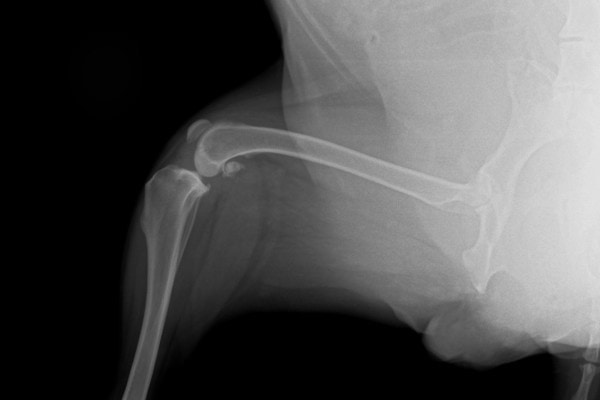
An estimate of the dog TPLO surgery cost
Additionally, the veterinary team will most likely give you an estimate for the cost of the TPLO. It can be helpful to know the price ahead of time so you can ensure you can afford it. Often, TPLO surgery can cost thousands of dollars. This means you may need to save up a bit, borrow money from a friend or family member, apply for a medical line of credit (e.g. CareCredit®), etc.
And sometimes this means TPLO surgery isn’t financially possible. If this is the case for you, please don’t feel ashamed or like you have let your dog down. Instead, talk to your vet about how else you can keep your dog comfortable. Surgery is still the gold standard, but there are ways to treat your dog’s ACL tear without surgery.
How can you prepare at home for your dog’s TPLO surgery?
After you schedule the TPLO, but before the day of surgery, it can be helpful to make a few preparations at home for your dog’s TPLO recovery.
Set up a recovery area
First off, I recommend creating a recovery area for your dog that is comfortable and keeps him or her confined. Some people use a crate or exercise pen. Others may gate off a small area of their house. Either way, the goal is to give your dog enough space to take a few steps, but not so much that he or she can run, jump, or otherwise be too active.
It is a great idea to put a thick dog bed in the recovery area. This gives your dog somewhere comfortable to rest. Alternatively, you can use blankets. But be aware that they can sometimes bunch up and trip your dog—which is the last thing you want while he or she is recovering.
Ideally, the recovery area is in a location where your dog can still feel like he or she is part of the daily family activities. But it should not contain anything your dog could jump up on. Also, it is best not to let other pets have access to the recovery area. You don’t want your dog to delay the healing process by roughhousing with his or her buddies.
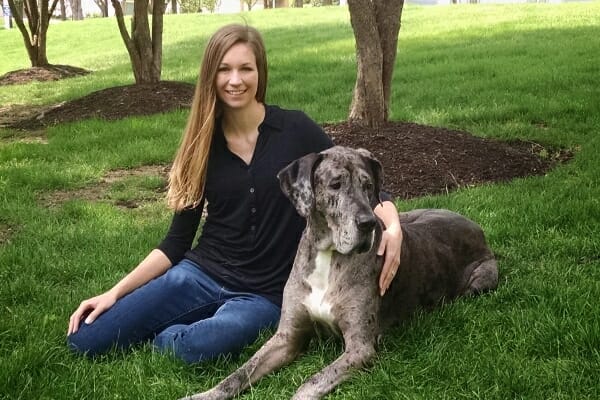
Collect some useful recovery tools
You may also want to find, borrow, or purchase:
- A sling or mobility harness to help support your dog’s hind end during the first few days. This is especially important if your dog has TPLOs on both hind legs at once. Two great options are the GingerLead® Support and Rehabilitation Harness (for as-needed hind end support) or the Help ‘Em Up® Mobility Harness (a wearable harness you can use to provide full body support for rising or walking).
- A six-foot leash and collar (or a slip leash) that you can place by the door. That way if someone comes to the door and your dog isn’t confined to the recovery area, you can quickly leash your dog to keep him or her under control. Plus, you will need a six-foot leash for walking your dog after surgery.
- Some sort of “Do not ring the doorbell” sign for your front door if your dog normally goes nuts when he or she hears the doorbell.
- Dr. Buzby’s ToeGrips® dog nail grips to improve your dog’s traction on the floor. Alternatively, you can lay down non-slip rugs or mats for your dog to walk on. Both options can decrease the chances your dog will slip and fall during the post-op period.
- Safe chew toys for dogs, puzzle toys, snuffle mats, or other ways to keep your dog mentally active during recovery.
- The treats or foods you may need to use to get your dog to take pills. You don’t want to have to make a late night grocery run for tempting foods if your dog won’t take pills.
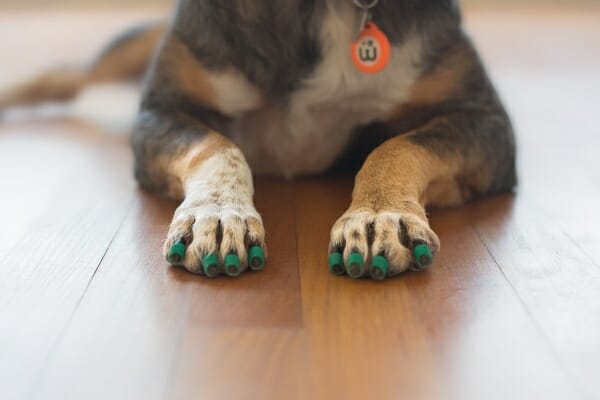
Prepare your dog for confinement and wearing an E collar
If time permits, you may also want to do some practice runs where you put your dog in the recovery area for a few minutes with a fun toy or treat. This can help your dog get used to the idea of being confined to that area before he or she has to stay there after surgery.
Additionally, if you think your dog will be bothered by the E collar and you already have one (or can get one) you may want to work with your dog to get him or her used to wearing it. Doing this ahead of time can reduce everyone’s stress in those first few post-op days.
What can I expect the day of surgery?
When surgery day arrives, you will probably drop your dog off early that morning. The veterinary team will perform a physical exam and look at his or her blood tests for dogs. Then they will finalize the anesthetic and surgical plan.
Once the surgeon completes the procedure, you will get a phone call letting you know how the surgery went and when you can pick your dog up. Some surgeons may recommend that your dog stays overnight (or longer) while others may send your dog home the same day.
When it is time to pick your dog up from the veterinary hospital, the veterinary team will discuss what to expect during the recovery period. And they will give you a list of post-operative instructions. Then you get to head home with your dog.
What does TPLO surgery recovery look like?
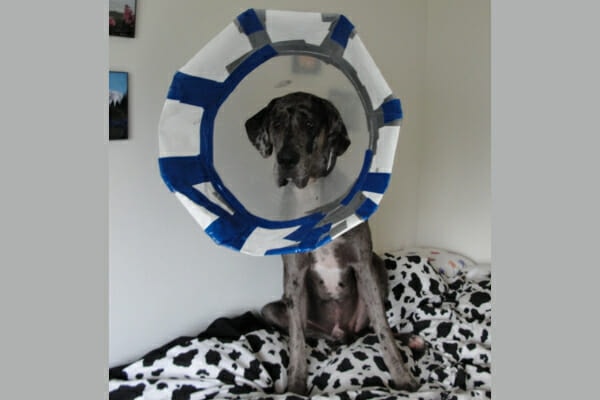
If you pick your dog up within the first 24 hours (or so) after surgery, he or she will probably not be using the leg. But most dogs usually start bearing a small amount of weight by 48-72 hours post-op. Over the next two weeks, you should start seeing your dog use the TPLO leg more and more. Then, by four weeks post-op, most dogs are still limping, but will put weight on the leg consistently. And at 8-12 weeks post-op, some dogs may be walking normally, while others are still limping occasionally or mildly.
Post-op instructions
In addition to discussing your dog’s recovery timeline, the surgeon will also give you a detailed list of instructions for your dog’s recovery. This list can vary some, but in general, you may be instructed to:
- Keep your dog confined to a crate or small room (the recovery area we discussed earlier). Initially, you should take your dog outside on a six-foot leash just long enough to go to the bathroom. But the orthopedic surgeon will let you know when you can start increasing your dog’s physical activity.
- Prevent your dog from running, jumping, climbing stairs, and roughhousing during the recovery period. Being active too soon can slow down healing or increase the risk of complications. Sometimes the vet may recommend a medication with sedative and anti-anxiety properties (e.g. trazodone for dogs) for dogs who are finding it difficult to rest and remain calm.
- Administer pain medications on a regular schedule as advised by your vet. These may include non-steroidal anti-inflammatory drugs (NSAIDs) such as carprofen for dogs, or other pain medications like tramadol for dogs or gabapentin for dogs.
- Use heat or cold therapy on the affected leg.
- Perform passive range of motion exercises for dogs (under the direction of your surgeon or veterinary rehabilitation professional).
- Work with a veterinary rehabilitation practitioner or follow a provided rehab program.
- Bring your dog to the clinic for laser therapy for dogs to reduce pain and inflammation.
- Keep your dog’s E-collar on to prevent him or her from licking the sutures.
- Prevent your dog from sliding on slippery floors. (This is where ToeGrips or yoga mats come in.)
Follow up with the surgeon for rechecks and any concerns
The orthopedic surgeon will want to recheck your dog at specific times while he or she is healing. However, during the initial recovery period, please also contact the veterinarian or veterinary surgeon if you notice:
- Your dog seems to be suddenly more painful
- Your dog is not using the leg after previously bearing weight on it
- The incision or leg itself looks abnormal (e.g. swollen, red, hot, or is leaking fluid)
- You have any other concerns
Depending on what is going on with your dog, the surgeon may want to see your dog before the scheduled recheck appointment to ensure no complications have occurred.
What are the common complications of TPLO surgery?
As is the case with any surgical procedure, complications can occur after TPLO surgery.
In a study of 1,519 TPLO procedures, major complications were seen in 3.1% of cases. And minor complications occurred in 8.3% of cases. The more common major complications included:
- Medial or lateral patellar luxation requiring surgical correction
- Joint infection
- Fracture of tibia/implant (plate and screws) failure
- Need for plate removal due to loosening or exposure, discharge from surgical site, abnormal X-ray appearance, or lameness
The more common minor complications included:
- Incisional swelling, inflammation, drainage, and bruising
- Tibial crest/patella fracture (noted on X-rays, but usually not symptomatic)
- Pin removal/migration
- Patellar tendon thickening
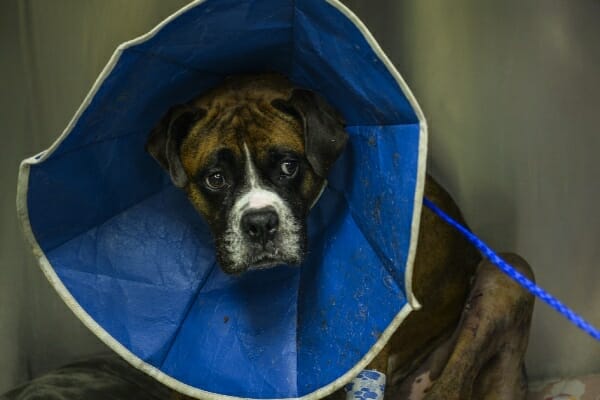
Dog limping months or years after TPLO surgery
Sometimes a dog might seem to recover fine. And then he or she starts limping again (or worse yet, not using the leg) several months, or even a year or more after the TPLO. There are several explanations for this. They include some of the complications mentioned above, plus a meniscal tear or arthritis.
Meniscal tear
Especially if your dog’s knee is clicking and your dog is limping, your dog may have torn his or her meniscus in the TPLO knee. Depending on which study you read, somewhere between 1.9% and 28% of dogs who undergo one of the cruciate repair surgeries may develop a tear in the meniscus at some point after surgery.
However, it is not clear yet if this is truly a complication of surgery. It may also just be a consequence of abnormal joint dynamics.
Arthritis
Alternatively, it is possible that arthritis in the TPLO knee is causing pain (and sometimes a crunching or grinding sound in the knee). Dogs who have a ruptured cruciate ligament are bound to develop osteoarthritis in dogs as they age. Even with surgery, arthritis is an unavoidable consequence of altered joint mechanics. Therefore, the goal is to minimize the arthritic changes that occur in the joint.
One way to do this is to perform surgery to stabilize the knee joint sooner rather than later. Interestingly, out of the different surgical procedures, TPLO seems to be one that leads to less arthritis. (More on that in a bit.)
Additionally, it can be helpful to start your dog on a joint supplement for dogs such as Dr. Buzby’s Encore Mobility™ hip and joint supplement. Or you could consider Adequan for dogs, an injectable medication that can help slow the progression and decrease the symptoms of arthritis.
Rupturing the CCL in the other leg
While it isn’t actually a complication of TPLO surgery, dog parents should also be aware of the fact that approximately 50% of dogs will tear the cruciate ligament in the other leg. This is actually a good reason to move forward with a TPLO or other surgery sooner rather than later. The quicker the dog goes back to using the injured leg, the less weight he or she will be shifting to the other leg. This puts less stress on the other potentially-degenerating cruciate ligament.
What is the outlook for dogs who have TPLO surgery?
Understandably, dog parents who are facing a TPLO may want to know what the future looks like after surgery.
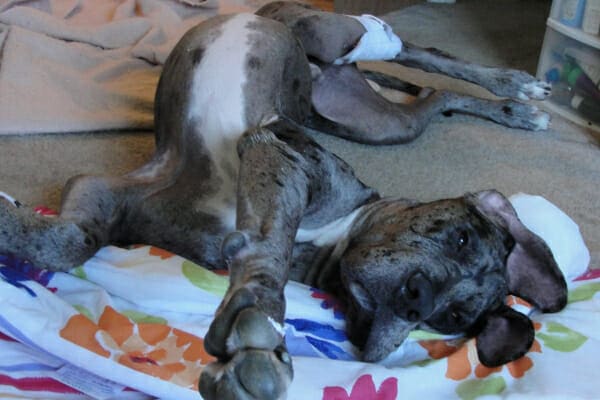
Long-term lameness scoring
To help answer that question, researchers looked at a combination of X-rays, examinations, and/or client questionnaires to evaluate long-term outcomes of dogs who had TPLO surgery. That study showed that up to 6.8 years post-op, 90.4% of cases had lameness results that were judged to be “excellent” or “good.” This is wonderful news because it demonstrates that TPLO surgery can give good functional results for years to come.
Arthritis progression
Another consideration is arthritis. As mentioned earlier, arthritis can definitely be a problem whenever a dog tears his or her cruciate. So the question isn’t really if the dog is going to get arthritis, but rather how soon the dog will start showing signs of arthritis and how severe with the arthritis be.
Any of the surgical repair techniques will decrease arthritis formation compared to no repair. However, a 2019 study in Veterinary Surgery indicated that at three or more years after surgery, arthritis on X-rays was more significant after a TTA than a TPLO.
As part of that study, dog parents also filled out questionnaires to evaluate their dog’s pain and mobility. The results indicated that dogs who had a TPLO had less morning stiffness, better jumping and climbing, less limping during mild activities, less interference with walking, and better overall quality of life. In other words, dogs who had a TPLO showed fewer signs of arthritis in dogs than those who had a TTA.
Additionally, a different study compared osteoarthritis development between dogs with a TPLO and lateral suture 12 or more months after surgery. The researchers determined that dogs with a larger increase in arthritis score were 5.78 times more likely to have had an ELSS than a TPLO.
These studies would seem to indicate that TPLO could be the superior procedure for decreasing arthritis formation. However, factors such as underlying damage to the joint cartilage or meniscus prior to surgery and the type of meniscal surgery may also contribute to the degree of arthritis. Therefore, it is hard to make a strict comparison.
Oliver’s recovery
Looking back, I don’t regret having the TPLO surgery done for my dog—not even for one second. Oliver was able to go on long walks and hikes and continue his romps in the dog park with minimal pain. Without the TPLO, this probably would not have been possible. Thankfully, he didn’t ever completely tear his other cruciate ligament. But I suspect he may have had a partial tear near the end of his life.
As he aged, arthritis did eventually take its toll. But he had eight more wonderful years with me after his TPLO. My sweet Oliver Pickles helped me meet my husband. He supported me through the challenges and triumphs of being a new vet. And he welcomed my first two children to our family.
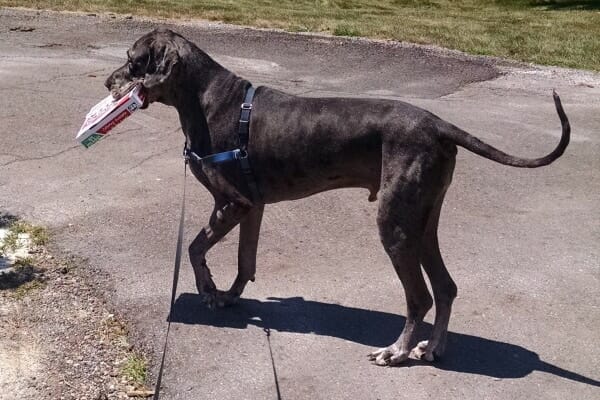
TPLO surgery is worth it
There isn’t anything particularly easy about going through a TPLO with your dog. But doing your research, preparing ahead of time, carefully following the post-op instructions, and contacting the vet with any concerns can go far in making it more manageable.
Those initial few weeks of recovery have their challenges for sure. But I think most dog parents would agree that it was worth it in the end. TPLO surgery can be a great way to stabilize the knee joint so your dog can be comfortable and mobile again. That way you can get back to walking, running, playing, and all the other activities you love doing with your dog.
Has your dog had TPLO surgery?
Please share advice or words of encouragement in the comments.


My beloved dog Che turned 12 in spring 2022, he is a 60 pound sweetheart. He loved chasing and frolicking with my other dog, a puggle. That spring, I noticed he was having some trouble with one of his back legs and I took him to my vet. They determined he had a torn CCL on one side and the other side was not so good either. One week later he saw the surgical vet, and by then he had torn the other side. There was an opening in the schedule the very next day, so they kept him overnight for surgery the next morning. He did very well, but I am an anxious individual and I was working the next 2 days solid so they kindly kept him until Saturday morning. I set him up in my small kitchen with his bed, yoga mats and water. He was not thrilled about this, and I kept him loaded up with gabapentin, trazadone and Rovera. Honestly, he did better than I did! One week later on a Saturday I was in the vet’s office sobbing, sick with worry, I received a mild lecture and I was reassured. Four weeks later the other side was done and the same routine was followed, minus the vet office melt down. In August he had his follow up Xrays done and he was allowed to climb stairs and jump on bed and furniture again. He had underwater treadmill therapy which was a big help in his recovery. Unfortunately, in December, he fell jumping on my bed, and then he fell again in the morning getting down. By that evening he seemed fine, maybe he had a little limp, but next day he couldn’t keep his back end up. In a panic I took him to the vet, they figured it was a disc and we went home with meds. By Sunday I was a mess, he was not worse, but I took him to the emergency vet. I did not opt for an MRI-cost and of no value to him in my opinion, and I was not interested in pursuing back surgery. I did end up going home with the harness made by Blue Dog. Turned out to be a lifesaver for him. Just an aside, most male dogs DO NOT need the harness with the loop for the penis-I was sold that but ended up getting the other back end for girls and boys which worked great. By late spring of 2023 I felt comfortable taking off the rear of the harness and I am holding it in reserve for icy, slippery weather. In September he was diagnosed with a cutaneous lymphoma, a small lesion that had recently developed on his lip. It was biopsied at same time as 2 other more worrisome looking lesions which were benign. He had a wide excision of the lip lesion, and his ultrasound and CXR were clear. He is now on chlorambucil and so far tolerating it. I am praying that he will do well. I am thankful I had the resources to pay for the TPLOs, for the rest I have needed a loan. I have to say that in the last few months he is so bright, cheerful and he loves his back yard (worrier me keeps him on leash back there still) and daily walks. If anyone out there wants to say a prayer for him too, please do. Looking back, I would not have allowed him to go back to climbing stairs and jumping on and off furniture because he is an older dog. My first floor is covered in yoga mats and dog beds, and no one is complaining!
Hi Claudina,
I am glad your boy was able to make a full recovery from both knee surgeries and his lymphoma scare. What a blessing you have been gifted with so much extra time with him! Thank you for sharing your success story with us. Wishing you both nothing but the best. Give your sweet boy a hug for me and keep up the good work!
My Dereon had a TPLO surgery about 3 years ago. She is slow walking and cannot grip when trying to stand. She also slips on floors if they don’t have rugs. She tore her ligament chasing another animal. She whined but didn’t stop running. When she finally stopped, her back leg was dangling. We were mortified.
But she had the surgery a few days later.
Hi Wendee,
Sorry to hear that your pup tore her CCL and needed surgery. It is crazy how dogs can sometimes push past the pain to keep running after another animal and then suddenly hold the leg up in pain when they stop. I’m glad you were able to have a TPLO done for her. If she is still having trouble getting a grip when standing or walking on slippery floors, she may really benefit from my signature product, ToeGrips. I have had so many dog parents over the years tell me how much ToeGrips have helped their dogs gain traction and walk more confidently, and the same could be true for her. I offer a 30-day money-back guarantee on the ToeGrips, which essentially means you are able to try them risk free! Also my customer service team is awesome so if you have any questions about sizing or need help troubleshooting, they would be happy to help. Thanks for sharing her story with us and feel free to reach out if you have any questions about ToeGrips!